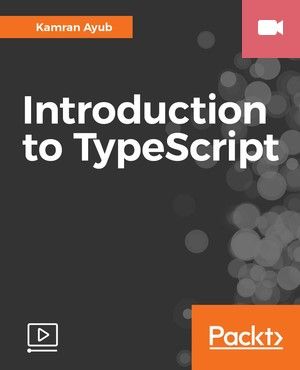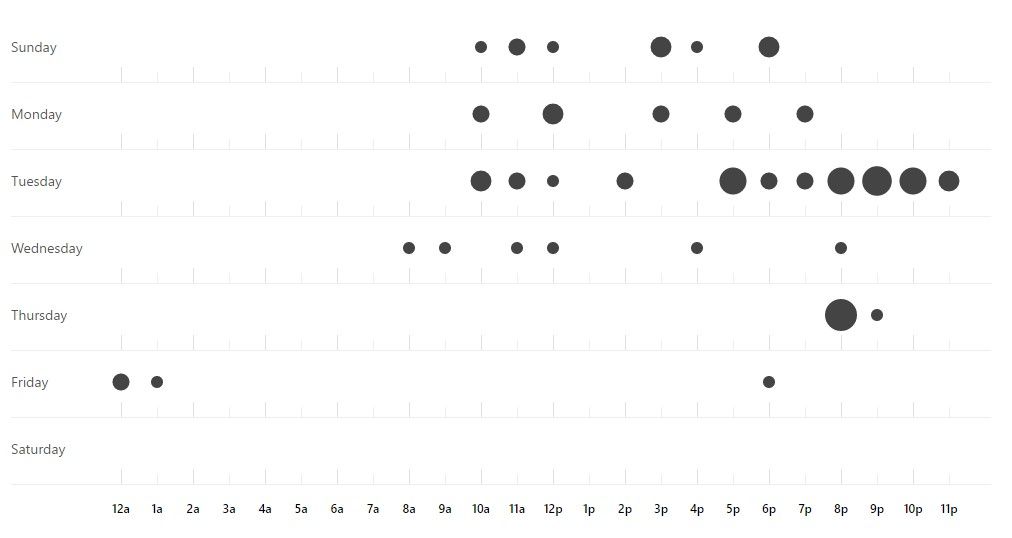Introduction to TypeScript Course Now Available
I'm very excited to share that the course I've been working on the past few months, Introduction to TypeScript is now available to purchase through Packt Publishing! I should have some discount codes to share soon (will Tweet/update when available).

You can watch the course overview if you want to learn what's in store.
Goals
My goals while developing the course were pretty simple:
Provide background on TypeScript
The first couple sections of the course focus on why TypeScript. Not only trying to answer, "Why would I use TypeScript?" but also, "Why is TypeScript even a thing?" I think it's important to understand why you're using a language and to understand the context in which to use it.
Learn by doing
Throughout the course the majority of content is presented inside of Visual Studio Code. Why? Because that's where you'll be working (or in some other IDE). After the first few introductory sections, the amount of slides I use in the rest of the course are mainly explanatory/summary slides. The rest is all in the code. Furthermore, I've built the course sample code to allow following along--each section has its own folder and it just starts at the final state, so you can begin where I leave off.
The other motivation to focus so much on actual coding is the fact that one of the primary reasons to use TypeScript is for productivity. And you just can't tell someone how much time they will save, you need to prove it. I hope by the sheer amount of coding samples I walk through that it will be crystal clear how useful TypeScript can be.
Focus on real-world samples
The middle of the course introduces language concepts and features by building a sample application from scratch. I purposefully designed an example that didn't assume prior knowledge of any other JavaScript framework or library--I want people to "go in fresh." This is to allow the viewer to see TypeScript in a purely isolated context to learn the language and how to design their own applications from scratch. I cover environment setup, refactoring, and testing.
In the latter part of the course, I switch to migrating several "vanilla" JavaScript codebases. I intentionally chose publically available projects. Why? Because I knew if I wrote contrived samples to migrate I would be biased towards designing it with TypeScript in mind. Instead, I chose libraries that other people wrote so they could be more raw and real. The only thing I did was choose examples that would allow me to introduce more concepts and workflows that people might encounter in the real world and that could support migration in a reasonable time for a course.
Post-mortem
This was my first course I developed myself. I was happy with the folks I worked with at Packt and I think I did a good job planning out work. I did not do a good job at estimating the amount of time up front--I think I had anticipated a 3 hour course and the final time is about 8 hours. I'm very happy with all the produced content but man that was a terrible estimate. Now I know for the future what to expect so I'm hoping future courses will have better up-front time estimates.
The editors I worked with remarked that I was a very good author to work with and wondered what tips I could share to help other authors keep to their schedule (we finished early! The course was expected to be released in February). Each section was due about 6-7 days apart and this is how I split the work to make my evenings and weekends manageable:
Code first (1-2 days)
Each section comprises of about 3-4 videos. I would tackle one section at a time, where I'd begin by writing all the code examples first. Why? Because even I didn't quite know what I'd learn when I started writing the code. As I wrote the code, I'd take down notes on what I wanted to highlight, what obstacles I ran into, and I'd mentally picture how I'd walk through the code to get to the end result.
This is by far the most time-consuming phase of making the course and I'd usually do this part on Sundays and Tuesdays (that worked best for my schedule, see Punchcard below). It's also where I learned the most and did the most research.
Content next (Evening)
Once the code was written, I had a clear picture of where to begin and where to end. Then I'd spend time on the slides--writing up any content that needed an introduction or explanation, the goals of the section, and a summary of everything the viewer should have learned.
In retrospect, this is the step I should have written all the required metadata for. The metadata is required for distribution of the course and I waited until the end to do it all, it would be have been more efficient to do it during this step.
Almost exclusively I worked on this during the evenings in the week. Some presentations took longer to make than others, depending on how much content I needed to cover.
Record last (Evening)
After the code and slides were done, I recorded. Using the software provided, I recorded each video in a single session, usually after dinner. My wife would go downstairs with the dog and I'd let her know when I was done. There were only a couple sections where I had to split recording into two days, otherwise I could usually do it in one night. I'm a perfectionist, so any part of the session I messed up I just started that part over. Each minute of produced material was about 2.3 minutes of raw material, so for a 20 minute video I'd spend about 46 minutes recording. Mainly this was because I didn't write a script beforehand or anything, I just tried to "present" and when I stumbled or made a mistake, I'd just start that bit over again.
A few things I did to minimize headaches during editing:
- Don't move the mouse while speaking in case of mistakes/cutting
- Minimize or eliminate parts of the screen that change dynamically (file explorer, clocks, taskbar, notifications)
- Clear the terminal before each step. It would look weird to have different command history being shown between cuts
- Ensure the mic was positioned consistently between sessions (I have a boom arm)
- Ensure the mixer was always the same settings each session (I never touched the settings after I started recording the first video)
I think the end result turned out really well because of the steps I took to minimize how much of the screen/sound changed during recording. All in all, I don't think any section took more than 2-4 hours to record.
Don't be afraid to change the outline
The original outline of the course was a bit different than what ended up being final. As I worked through each section, sometimes topics that I had planned to cover later came up sooner than expected. Rather than trying to avoid it, I just modified the outline to compensate. Overall, there was only one case where I had to move/merge sections and the editors were able to work with me on it--it ended up being way better than the original plan I had.
Stats
I can use these basic stats to help estimate any other courses I work on:
- Raw unedited video: 19 hours, 5 minutes
- Final produced video: 8 hours, 17 minutes
- Days to produce: Nov 11 - Jan 18 (68 days or 10 weeks)
- Course sample code commits: 78
- Estimated time spent: 60-80 hours (6-8 hours per week)
Git Commit Punchcard

You can see clearly that the majority of time was spent in the evenings but hardly after midnight--there was one instance I had to stay up a bit late to finish. You can also see I took advantage of my holiday break (Thanksgiving and Christmas) to work during the day. Sun-Tue were coding days whereas Wed-Fri were mainly recording or content creation. Thu-Sat nights were almost always free, perfect for spending time with friends and getting other work done.
Data is useful, especially to understand how much time goes into an endeavor like this--time is money, after all. For subsequent courses I plan to store all course material in Git (including slides/metadata) and also use something like RescueTime to track my time spent in the background. That will give me a much clearer picture of time spent on the course.
What's next?
While it would be ideal to do the follow-up course to this one immediately, I didn't know what my schedule would look like after my first kiddo arrives. The editors and I agreed that it didn't make sense for me to commit to doing another course so soon with such an unknown schedule. Once I have some idea of how much time I have, I'll be thinking about other courses. It's more important that I spend time with little Ayub first.
